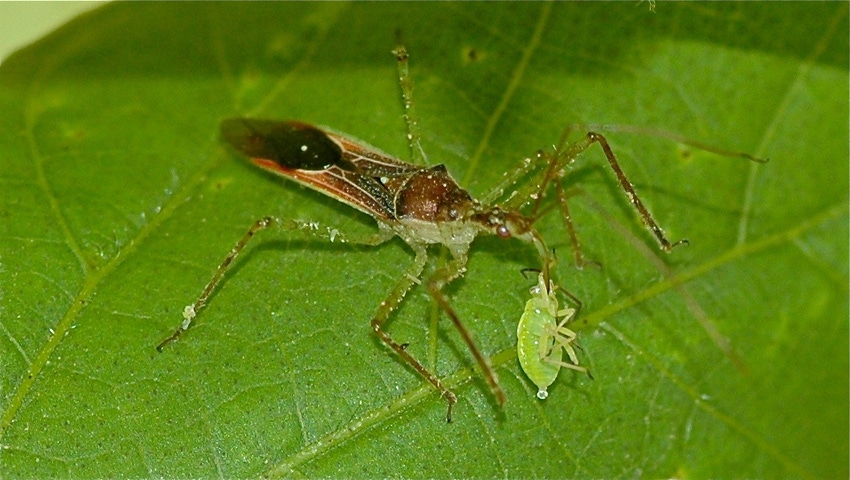August 25, 2011

By Lydia Brown, Tim Vandervoet, and Peter Ellsworth, University of Arizona, and Steven Naranjo, USDA-ARS
As Arizona’s largest predators found in agricultural fields, assassin bugs (Family Reduviidae) play an important and sometimes surprising role in biological control.
The most common and beneficial genera are Zelus and Sinea which feed on other insects as nymphs and adults. These bugs stalk and ambush prey, skewer it with the needle-like beak, and inject it with venom.
In Arizona cotton, Zelus renardii Kolenati is the most common species. The assassin bug contributes the most to biological control.
Zelus species have slender front legs covered in a sticky substance to aid in catching prey. Especially as nymphs when the entire body exudes the sticky substance, Zelus species often have debris stuck to the body including whiteflies or other small insect cadavers.
The other assassin bug found in Arizona cotton is the spined assassin bug, Sinea confusa Caud. Similar to a praying mantis, the front legs are spined, often held up in front of the body, and used to grasp prey.
Due to the large size (1/2 to 3/4 inch long), assassin bugs can consume almost any insect encountered including whiteflies, lygus, and even other beneficials. Assassin bugs play a special role in the arthropod food web acting as ‘apex’ predators without other predators of their own.
Assassin bugs prefer to feed on slower moving prey including caterpillars (e.g., beet armyworms and budworm/bollworms), but Bt cotton has changed what is on the menu. With fewer caterpillars to eat, Zelus depends on more common prey, including lygus nymphs, which can enhance the biological control of this key pest.
Recent studies show that broad-spectrum insecticides kill Zelus and other large predators (e.g., Nabids or Damsel bugs) releasing lygus populations from biological control and causing lygus to resurge more quickly.
However, Zelus can also negatively impact biological control. For example, lacewing larvae, which look similar to caterpillars but help to control aphids, are a favored prey of Zelus. By consuming lacewings, Zelus may sometimes reduce the biological control of aphids.
As an apex predator, assassin bugs can impact the cotton food web in important ways and usually help keep pests in check.
To view the insect photos related to this article, click on this link: http://ag.arizona.edu/crops/cotton/agronomic_ipm.html.
You May Also Like




